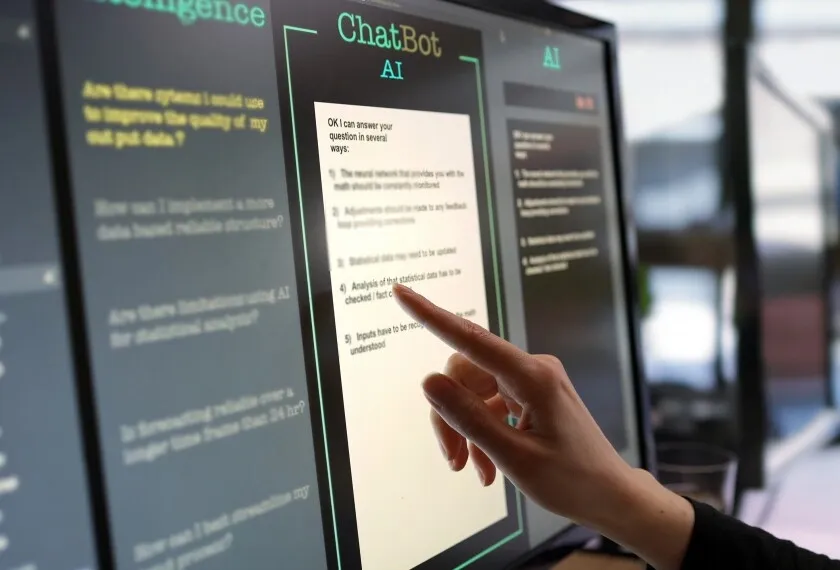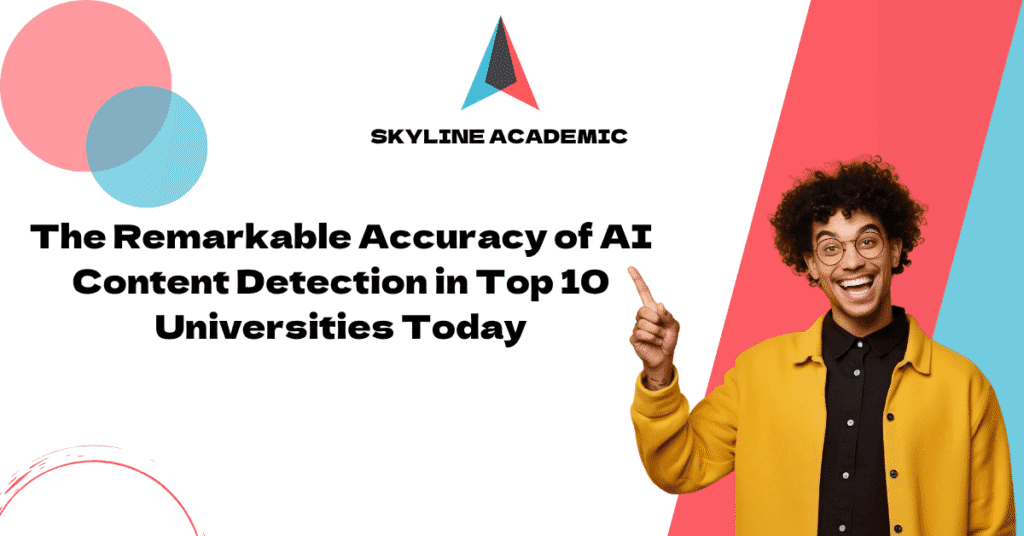The Remarkable Accuracy of AI Content Detection in Top 10 Universities Today
AI content detection raises serious concerns among universities since 46.9% of college students use AI technology for their studies. Skyline Academic’s claims of 99% accuracy in spotting AI-generated content don’t match reality. Detection services struggle to achieve 80% accuracy, which means they make mistakes with every fifth paper they analyze.
Professors frequently ask “was this written by AI?” while reviewing suspicious work. The question remains – can these AI detectors serve academic needs reliably? Facts paint a different picture. Studies reveal that only 25% of teachers can confidently tell AI-written content from student’s work. Turnitin’s 15% miss rate of AI text creates challenges for professors who need accurate detection methods. The system’s reliability comes into question as it wrongly flags human-written documents—including the US Constitution—as AI-generated content. Non-native English speakers face an even bigger challenge with false positives reaching 70%. In this piece, we’ll look at AI content detection technology’s current capabilities and help educational institutions navigate this complex digital world.
Why Universities Are Focused on AI Detection
Universities nationwide have stepped up their AI content detection efforts as tools like ChatGPT gain popularity in academia. Their concerns stem from several key educational priorities.
Maintaining academic integrity
Academic integrity remains the cornerstone of education. Without it, our educational system loses its value. The University of Pennsylvania’s disciplinary report showed that cases of “unfair advantage over fellow students” jumped seven times, which included “using ChatGPT or Chegg” [1]. Academic plagiarism stands among the most serious violations because it undermines the way we measure and develop student skills [2].
Schools know they need strong AI content detection systems to make sure students submit their own work instead of using sophisticated AI tools. “Education becomes worthless without academic integrity,” notes one expert [3]. Schools have started using detection tools to protect their academic standards and the value of their degrees.
Preventing unfair advantages
AI detection has become crucial because these tools can create unfair advantages. Studies show that 12% of student ChatGPT users saw their GPA improve, with average grades jumping from 2.9 in fall 2022 to 3.5 in spring 2023 [1]. The data also reveals that 51% of students would keep using AI even if their schools banned it [1].
This presents a real challenge for universities. “Unrestricted access to AI content detection tools creates an uneven playing field, favoring those who exploit these technologies over those who rely solely on their own understanding” [4]. Detection tools help schools level the playing field and evaluate students based on their actual knowledge.
Understanding student learning
Student learning goes beyond just academic integrity. Teachers worry that students might lose their ability to think critically if they depend too much on AI tools [5]. Students miss out on building essential thinking skills when they let AI do their work.
Faculty members worry they might give better grades to AI-generated work than to genuine student efforts [5]. AI content detection helps schools understand how students learn and ensures grades reflect student abilities rather than AI capabilities.
Schools’ push for AI detection shows their steadfast dedication to protecting education’s core values—integrity, fairness, and real learning—as AI becomes more common in education.
How Professors Detect AI in Student Work

Image Source: Education Week
Teachers now use several strategies to spot AI-generated work because students rely more on these tools for assignments. No detection method works perfectly, so professors combine different approaches.
Comparing with previous writing samples
Teachers review their student’s past work to detect sudden changes in writing style or quality. As one instructor noted, “Does the vocabulary, sentence structure, or complexity of ideas feel substantially different?” [6]. This approach stands out as one of the most reliable methods against evolving AI capabilities. Students who normally make grammar mistakes but submit perfect work raise red flags. Teachers watch for missing personal quirks – those unique patterns and occasional errors that make student writing authentic.
Verifying sources and citations
Citation checks form a big part of AI detection since AI content detection tools often invent non-existent sources. A professor found that there was a paper claiming “coal companies have been able to avoid taking responsibility for the disease by using legal and medical tactics to deny workers’ compensation claims” though the original article never discussed these topics [7]. Source verification proves effective by confirming whether cited materials exist or contain made-up information. Some professors’ reports show papers referenced mining disasters absent from original sources [7].
Asking students about their process
Face-to-face conversations remain one of the best ways to verify work. Teachers set up meetings with students whose assignments seem suspicious. These discussions avoid accusations directly, but teachers ask students to explain complex points or describe their writing process [8]. A principal’s report showed that after discussing suspected AI use, “the student admitted to using a generative AI tool” [9].
Using AI detector tools
Teachers use detection software like Turnitin, GPTZero, and Copyleaks despite their limitations. Turnitin admits its AI detection can miss approximately 15% of AI-generated text [10]. AI content detection tools don’t achieve perfect accuracy – GPTZero claims 98.5% accuracy [11], while Copyleaks reports 99.12% [7]. Teachers now see these tools as just one part of getting a full picture rather than absolute proof.
How Accurate Are AI Content Detection Tools Today?
Research shows AI detectors have nowhere near the perfect accuracy they claim. Many universities that rely only on these tools might make serious mistakes while evaluating student work.
False positives and false negatives
AI detectors often make two types of mistakes. They flag human writing as AI-generated (false positives) and miss actual AI content (false negatives) [12]. These errors make it hard to trust these systems and can unfairly hurt honest students. Studies show that even free AI detection tools wrongly marked over 27% of legitimate academic text as AI-generated [13]. Many educators now realize that AI content detection tools should be just one part of their overall evaluation approach.
Bias against non-native English speakers
The biggest concern lies in how these tools treat non-native English speakers. Stanford researchers found that while detectors worked almost perfectly with US-born students’ essays, they wrongly labeled 61.22% of non-native English student essays as AI-generated [14]. The situation gets worse – all seven AI detectors tested unanimously marked 19% of non-native English essays as AI-generated [14]. This bias exists because non-native speakers usually score lower on measures like lexical diversity and syntactic complexity that these detectors use.
Performance of top tools like Turnitin and Originality.ai
Turnitin admits its AI detection tool misses about 15% of AI-generated text [10]. The company keeps false positives under 1% as their top priority [15]. Independent tests show Originality.ai performs better with its “Lite” model, reaching 98% overall accuracy and less than 1% false positive rate [16]. <Check out Skyline Academic’s AI content detection tool to see how accurate AI detection can be.>
Can students bypass detection?
Students have found that there was several ways to avoid AI content detection. They run AI-generated essays through paraphrasing websites like Quilbot [17], ask ChatGPT to create more complex content [18], or edit flagged sections [17]. One student anonymously shared that they use “GPTZero to [ensure] there is no more ChatGPT detection” before submitting their work [17]. A University of Pennsylvania study confirms that basic tricks like adding whitespace, making spelling mistakes, or using homoglyphs can make detectors about 30% less effective [19].
Best Practices for Teachers and Institutions
Academic integrity needs effective strategies that go beyond AI content detection tools in today’s education world. Current technology has limitations, so educators need an integrated approach to handle AI usage in academia.
Use AI detectors as one part of a larger strategy
Universities should not depend only on AI detection software. Research suggests these tools don’t work reliably, and the best detectors achieve 80% accuracy at most [6]. These detection tools show bias against certain student groups, especially when you have non-native English speakers [20]. Stanford’s research showed this worrying pattern of discrimination [20]. Rather than using detection software as final proof, institutions should:
- Create authentic assessments that need personal reflection or analysis
- Support assignments with multiple checkpoints
- Add frequent low-stakes feedback opportunities [2]
- Talk to students to verify their understanding
Encourage transparency with students
Trust builds on clear communication about AI policies. Teachers should add clear syllabus statements that explain acceptable AI use and required documentation [21]. One institution points out, “Instructors should be direct and transparent about what tools students are permitted to use and the reasons for any restrictions” [22]. Both sides need this transparency—institutions should be open about their own AI usage in administrative processes [23]. Skyline Academic’s AI content detection tool can help improve your academic integrity strategy.
Track writing progress using Google Docs
Google Docs’ powerful version history feature records every document change. Teachers can see if students added content bit by bit (suggesting human writing) or pasted large blocks (suggesting possible AI generation) [24]. Students who write in Google Docs and share editable versions help faculty track authentic writing patterns without depending on flawed detection algorithms [25].
Train faculty on AI literacy
Institutions must invest in AI literacy training. Faculty need to learn about AI’s capabilities, limitations, and ethical aspects to guide students well [21]. They should know that AI content detection tools can help learning when used correctly [26].
Conclusion
The Future of AI Detection in Academia
Our deep dive into AI detection shows a tricky challenge for schools and universities. Detection tools claim perfect accuracy, but they’re right only about 80% of the time. This means they might miss or wrongly flag one paper in every five. It also hits non-native English speakers harder, with false flags showing up 70% of the time.
Schools need a balanced strategy. Teachers shouldn’t just rely on detection software. They should mix tech tools with smart teaching methods. This includes creating assignments that show each student’s unique thinking and tracking their writing progress through Google Docs. Teachers should also keep talking with students about what’s okay when using AI.
“Was this written by AI?” This question will without doubt keep teachers up at night. But the facts show we can’t trust any single detection method completely. So schools should build spaces where students learn both what AI can and can’t do, while building their own thinking skills.
You can’t protect academic honesty just by catching cheaters. We need to encourage real learning. AI detection tech will get better, but note that human judgment, clear rules, and well-designed tests remain our quickest way to fight cheating. We don’t need perfect detection. We need education that gets students ready to work in a world where AI help is normal.
FAQs
Q1. How accurate are AI content detectors in identifying AI-generated text?
Current AI content detection tools are not as accurate as often claimed. The best detectors achieve around 80% accuracy, meaning they can be wrong about one in five papers. This limitation highlights the need for a more comprehensive approach to evaluating student work.
Q2. Are non-native English speakers at a disadvantage when it comes to AI detection?
Yes, there is a significant bias against non-native English speakers in AI detection. Research has shown that AI detectors can misclassify up to 61% of essays written by non-native English speakers as AI-generated, creating an unfair situation for these students.
Q3. How are professors adapting to detect AI-generated content in student work?
Professors are using multiple strategies, including comparing with previous writing samples, verifying sources and citations, asking students about their writing process, and using AI detector tools. However, they increasingly view these methods as part of a holistic assessment rather than definitive proof.
Q4. Can students bypass AI detection systems?
Yes, students have found various ways to evade AI detection. Common techniques include using paraphrasing websites, asking AI to generate more complex content, or making small edits to flagged sections. These methods can significantly reduce the effectiveness of detection tools.
Q5. What are some best practices for universities in dealing with AI-generated content?
Universities should use AI detectors as just one part of a larger strategy. Other recommended practices include encouraging transparency with students about AI policies, tracking writing progress using tools like Google Docs, designing authentic assessments, and providing AI literacy training for faculty members.
References
[1] – https://www.timeshighereducation.com/campus/it-time-turn-ai-detectors
[2] – https://ai.ufl.edu/teaching-with-ai/expanding-the-ai-curriculum/guidance-for-instructors/
[3] – https://assignmentgpt.ai/blog/why-ai-content-detection-matters-for-education
[4] – https://www.quadc.io/everything-you-need-to-know-about-ai-in-higher-education
[5] – https://mitsloanedtech.mit.edu/ai/teach/ai-detectors-dont-work/
[6] – https://www.eastcentral.edu/free/ai-faculty-resources/detecting-ai-generated-text/
[7] – https://tilt.colostate.edu/comparing-ai-detection-tools-one-instructors-experience/
[8] – https://packback.co/pedagogy/professor-guide-to-ai-text-detection/
[9] – https://www.edweek.org/technology/more-teachers-are-using-ai-detection-tools-heres-why-that-might-be-a-problem/2024/04
[10] – https://www.insidehighered.com/news/tech-innovation/artificial-intelligence/2024/02/09/professors-proceed-caution-using-ai
[11] – https://educraft.tech/identifying-ai-written-essays/
[12] – https://blog.oppida.co/ai-detectors
[13] – https://facultyhub.chemeketa.edu/technology/generativeai/generative-ai-new/why-ai-detection-tools-are-ineffective/
[14] – https://hai.stanford.edu/news/ai-detectors-biased-against-non-native-english-writers
[15] – https://www.turnitin.com/blog/understanding-false-positives-within-our-ai-writing-detection-capabilities
[16] – https://www.quizcat.ai/blog/ai-plagiarism-tools-side-by-side-comparison
[17] – https://theburlingameb.org/7898/news/students-bypass-ai-detection-with-novel-forms-of-cheating/
[18] – https://community.openai.com/t/how-can-i-prevent-my-ai-generated-content-from-being-detected-by-ai-detectors/692225
[19] – https://edscoop.com/ai-detectors-are-easily-fooled-researchers-find/
[20] – https://lile.duke.edu/ai-and-teaching-at-duke-2/artificial-intelligence-policies-in-syllabi-guidelines-and-considerations/
[21] – https://poorvucenter.yale.edu/AIguidance
[22] – https://teaching.charlotte.edu/teaching-support/teaching-guides/general-principles-teaching-age-ai/
[23] – https://genai.illinois.edu/best-practice-transparency-in-ai-use/
[24] – https://www.digitalinformationworld.com/2024/06/spot-ai-generated-writing-through-google-docs-history-feature.html
[25] – https://doit.umbc.edu/post/150153/
[26] – https://www.ccdaily.com/2024/12/strategies-to-counteract-ai-cheating/


![Is Cyber Security Hard Expert Guidance Makes It Easy [2025]](https://skylineacademic.com/wp-content/uploads/2025/10/is-cyber-security-hard-expert-guidance-makes-it-easy.png)
